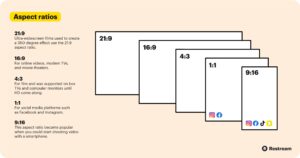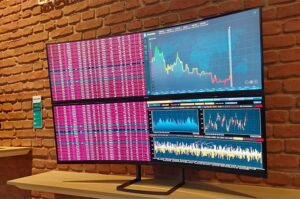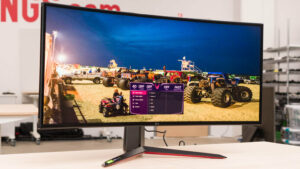In a highly-competitive world like today, it’s essential to have the right tools to enhance your productivity. An ultrawide monitor is one such tool that helps you maximize productivity. But that’s not all; ultrawide monitors are great for gaming, content creation, and consumption. Of course, you must know precisely what to look for when buying such a monitor.
While the size, panel type, and resolution are prominent features most users look at; it’s the aspect ratio that determines whether the monitor serves its intended purpose. Not all ultrawide monitors are created equal, making it confusing to select one that offers the correct aspect ratio for your need.
What’s worse, manufacturers offer non-standard variations in aspect ratios. While these unconventional aspect ratios help some users, most users need clarity for the selection process. So, in this article, we’ll explain everything you need to know about aspect ratio on ultrawide monitors.
Resolution Vs. Aspect Ratio
A monitor’s resolution and aspect ratio are two distinct parameters that are often mistaken to be the same.
The resolution is the total number of pixels that a screen has. For the sake of marketing, manufacturers denote this parameter using terms like 4K, FHD, QHD, and whatnot. Naturally, the higher the number of pixels, the more precise the image appears on-screen.

Image Credit: Restream.io
For simplicity, think of it as the multiplication of the number of pixels in a horizontal line with that number of pixels in a vertical line. The manufacturer also uses this to denote the resolution. So, an FHD screen would be 1920×1080, where 1920 pixels are placed in a single line from left to right and 1080 pixels in a single vertical line. Remember this, as we’ll revisit this example in a minute.
Aspect Ratio And Everything You Need To Know About It
The aspect ratio defines the layout of these pixels on the screen. Think of it as the ratio between the width and height of the screen. This is where it gets tricky. You’ll have to refer to the resolution to know the aspect ratio.
So, a 1920×1080 resolution has a 1920:1080 ratio, where 1920 pixels define the width and 1080 pixels define the height. Mathematically, you can simplify this ratio to 16:9, which becomes the screen’s aspect ratio.

Image Credit: Restream.io
Here is another example for better understanding. Let’s say a screen has a resolution of 2560×1600 pixels. So, the ratio of the width to the height is 2560:1600, and when you simplify, the aspect ratio is 16:10.
Having understood this, you may have a question.
Screen Size, Resolution, and Aspect Ratio: They Are Related
The aspect ratio and size of the screen are directly related, and the resolution is a function of the screen size (and pixel pitch). Naturally, the smaller the pixel size, the more pixels you can accommodate in a given area, meaning the screen size. By inference, therefore, the aspect ratio depends on resolution, making all three parameters dependent on each other.
To understand this better, read these statements.
- It is possible to have the same aspect ratio on two different size screens (and vice versa).
- The aspect ratio will change with the size only if you select a different form factor, i.e., widescreen, ultrawide, or super-ultrawide.
- Different screen sizes will have different resolutions if the pixel pitch remains the same.
- It is possible to have the same resolution on different monitor sizes by varying pixel pitch.
We can confuse you (and ourselves) with more such statements. But the point is that the three parameters are equally important, and you must keep them in mind while buying a monitor.
Most Popular Resolutions of Common Aspect Ratios
Here is a list of the most common aspect ratios, their most popular resolutions, and their marketing names.
| Aspect Ratio | Alternate | Resolution | Marketing Name |
| 32:9 | 3.55:1
3.58:1 3.2:1 3.55:1 3.6:1 3.55:1 |
7680×2160
5760×1600 5120X1600 5120×1440 4320×1200 3840×1080 |
Super Ultrawide UHD+
Super Ultrawide QHD+ DQHD+ DQHD Super Ultrawide FHD+ DFHD |
| 21:9 | 2.37:1
2.38:1 2.37:1 |
5120×2160
3440×1440 2560×1080 |
Ultrawide 5K+
WQHD Ultrawide FHD |
| 12:5 | 2.39:1
2.4:1 2.4:1 2.4:1 |
5760×2400
4320×1800 3840×1600 2880×1200 |
5K2K WUHD
Ultrawide 4K WQHD+ Ultrawide FHD+ |
| 16:10 | 1.6:1
1.6:1 |
2560×1600
1920×1200 |
WQXGA
WUXGA |
| 16:9 | 1.77:1
1.77:1 1.77:1 1.77:1 |
1920×1080
2560×1440 3840×2160 5120×2880 |
FHD
QHD UHD or 4K 5K |
While there are several other resolutions and aspect ratios, these are by far the most commonly used monitor specifications you’ll find on the market.
Aspect Ratios And Their Use Case
There are widescreen monitors, there are ultrawide screen monitors, and then there are super ultrawide screen monitors. Of course, each form factor has a different aspect ratio, but their utility often overlaps depending on the use case. We’ll get into that in a minute, but first, you’ll need to be familiar with three terms, black bars, letterboxing, and pillarboxing.
What are Black Bars? Why does it cause letterboxing and pillarboxing effects?
Remember the good old days of CRT (Cathode Ray Tube) televisions? Well, those televisions used an aspect ratio of 4:3. So most media production companies would edit their video frames to match that aspect ratio, even though their camera would record a wider frame.
However, if you watched a movie on your old TV (with the 4:3 aspect ratio), you would have noticed that the actual images were displayed in the center, and two black bars would appear above and below the picture. Here is an image to jog your memory.

Image Credit: phototraces.com
This would happen because the media company wanted to show you the widescreen format on a square screen. Hence, they’d use Black Bars to compose the frame into a square form. This is also known as letterboxing.
Pillarboxing would happen when you tried to view the 4:3 content on a widescreen display (say with an aspect ratio of 16:9). So, instead of the Black Bars appearing on the top and bottom of the screen, they appeared on the left and right.

Image Credit: phototraces.com
This Black Bar effect exists even today, and you’ll experience it each time there is a mismatch in the aspect ratio of the screen and the content you are viewing.
Super Ultrawide Aspect Ratio: 32:9
The 32:9 is exclusive to large 57-inch and to 49-inch super ultrawide monitors. These monitors take the horizontal dimension to the extreme, helping you enhance productivity with efficient multitasking. How?
With a wider (in this case, the widest) screen, you can open multiple windows side-by-side, saving effort and time switching between several windows. Moreover, it helps minimize the use of multiple monitors, if not eliminate the need for them altogether. And with lesser time spent navigating windows, you remain focused on your work and achieve results faster.

Image Credit: AnandTech.com
Imagine how easy it would be to make reports where you must cross-check data from several windows. The 32:9 aspect ratio was conceptualized for similar cases. What’s more, content creators and creative professionals love the 32:9 super ultrawide displays as they provide enough screen real estate to work with video (and images) shot in unconventional resolutions.
On the other hand, the 32:9 aspect ratio is overkill for content consumption or gaming. You won’t find content produced in a 32:9 aspect ratio, so you’ll experience image distortion in the form of Pillarboxing.
The Versatile UItrawide Aspect Ratio(s): 21:9 and 12:5
These two, 21:9 and 12:5, aspect ratios are the reason why ultrawide monitors are increasingly becoming popular. The ultrawide form factor has versatile uses. Its curved avatar provides an immersive gaming experience, and the increased screen real estate is perfect for enhancing productivity.

Image Credit: Unsplash.com
For movie buffs, it provides a visual experience similar to what you’ll get in cinemas without pillarboxing or letterboxing. Of course, not all movies are available in a 21:9 or 12:5 aspect ratio, and you’ll have to check out an additional parameter when looking for the title you want. A quick search on leading movie databases will reveal plenty of popular titles to choose from. But if you want a truly cinematic experience, consider a monitor with a 12:5 aspect ratio.
Curved 21:9 monitors provide the ultimate immersive gaming experience by covering your peripheral sight and giving you a commanding view of the gaming scene. Monitor manufacturers recognize the gaming market and offer high-performance 21:9 (and 12:5) gaming monitors.
But gaming on a 21:9 monitor isn’t devoid of its downside. Gaming monitors are expensive, and ultrawide gaming monitors are even more so. They also occupy a lot more space at the workstation. More importantly, not all gaming titles support this aspect ratio, so check the aspect ratio of the game before buying an ultrawide 21:9 monitor.

A 21:9 ultrawide monitor is also great if you are looking to enhance productivity. Ultrawide monitors offer the unique advantage of split-screen software that allows you to work simultaneously on several windows. They offer plenty of I/O ports that, when combined with features like Picture-by-picture, will enable you to connect more than one computer and work efficiently. Further, most ultrawide 21:9 monitors include a USB hub, allowing you to connect all your peripheral devices easily.
The Curious Case of the 12:5 (2.4:1) Aspect Ratio
Although most manufacturers market ultrawide monitors under the 21:9 aspect ratio, not all 21:9 monitors offer this aspect ratio “to a T.” Refer to the table highlighting the 12:5 aspect ratio; the resolutions it mentions are all the marketed under the 21:9 aspect ratio when in reality the aspect ratio is 12:5.

Image Credit: PCMonitors.info
Both these aspect ratios are primarily similar, and when you simplify the ratios, you notice a marginal difference of about 30-40 pixels (give or take). But the thing to remember is that on a frame that offers close to 3000-4000 pixels (left to right) in a line, a difference of less than 1% (read 30-odd pixels) won’t make a noticeable difference. Of course, if your work involves great precision, you’ll be better off with resolutions that offer exact aspect ratios.
The Aspect Ratio for Everyone: 16:9
The 16:9 aspect ratio is so popular that we are reasonably sure you are reading this article on such a screen right now. A widescreen 16:9 monitor is perfect for work and pleasure, making it the ideal display solution for your home office.
Most high-definition content on streaming apps like Netflix, Prime, YouTube, and whatnot uses the 16:9 aspect ratio, making it the easy choice when you are still determining what you need. It’s perfect for working professionals, as the widescreen allows you to view more cells while working on a spreadsheet.

Image Credit: Unsplash.com
Ranging from a 13-inch screen to a 17-inch screen, most laptops on the market use the 16:9 aspect ratio. Desktop users often prefer larger monitors, but it is possible to get the 16:9 aspect ratio on the screen size of your choice.
The Fringe Aspect Ratios: 16:10 and 3:2
While we have already covered the most popular aspect ratios, you’ll discover more when buying a display device. Manufacturers offer a 16:10 and 3:2 aspect ratio, though only a handful of such devices are on the market. The most popular is the Apple M2 MacBook Air, which has a 16:10 aspect ratio screen.
The 16:10 aspect ratio is designed to give you more vertical screen space than the 16:9 aspect ratio. Thus, you get a balance between a widescreen experience and the additional height, enabling you to view more lines of text while working. Work or pleasure, it gives you the best of both worlds, making it the ideal choice for small or home offices.
The 3:2 aspect ratio is aligned with enhancing productivity, making them more at home on an office work desk rather than for everyday use. The screens are almost square, so you won’t get a widescreen experience. Instead, you’ll love a 3:2 screen if you are a coder or your work involves writing or reading numerous lines of text.
Conclusion
An ultrawide monitor is not for everyone; not everyone would feel the need for such a monitor. But, the ultrawide monitor, especially the ones with the 21:9 and 12:5 aspect ratios, are versatile display units that find endless utility across all use cases.


![Best DD-WRT Routers [2023] 13 best routers](https://bytexd.com/wp-content/uploads/2022/11/best-routers-380x220.jpg)

![Best 3:2 Aspect Ratio Laptops [2023] 27 Laptops 3by2](https://bytexd.com/wp-content/uploads/2022/04/Laptops-3by2-380x220.jpg)

This ratio has to be for special stuff. As in science Art Media editing and other unique.